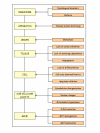Cancer: looking for simplicity and finding complexity
- PMID: 16480511
- PMCID: PMC1382260
- DOI: 10.1186/1475-2867-6-4
Cancer: looking for simplicity and finding complexity
Abstract
Cancer is one of the most complex dynamic human disease. Despite rapid advances in the fields of molecular and cell biology, it is still widely debated as to how neoplastic cells progress through carcinogenesis and acquire their metastatic ability. The need to find a new way of observing anatomical entities and their underlying processes, and measuring the changes they undergo, prompted us to investigate the Theory of Complexity, and to apply its principles to human cancer. Viewing a neoplasm as a system that is complex in time and space it is likely to reveal more about its behavioral characteristics, and this manner of thinking may help to clarify concepts, interpret experimental data, indicate specific experiments and categorize the rich body of knowledge on the basis of the similarities and/or shared behaviors of very different tumors.
Figures



References
-
- Bishop JM, Weinberg RA. Molecular Oncology. New York: Scientific American, Inc; 1996.
LinkOut - more resources
Full Text Sources
Other Literature Sources

